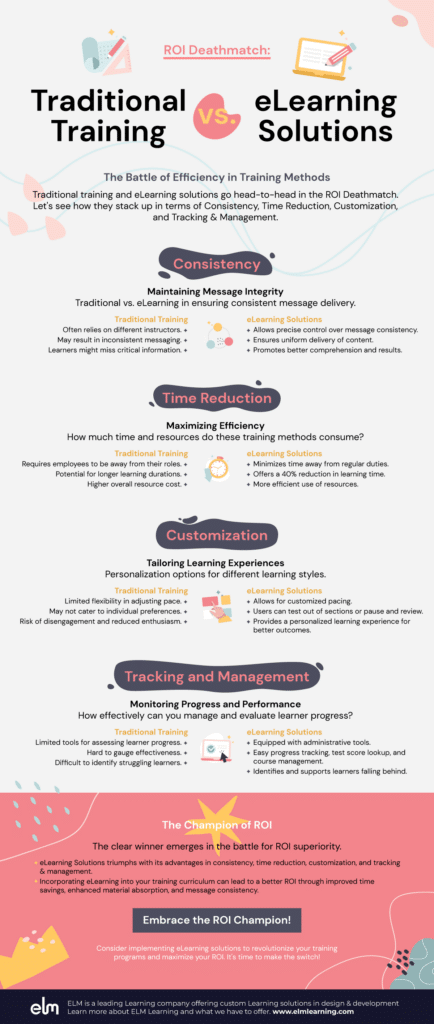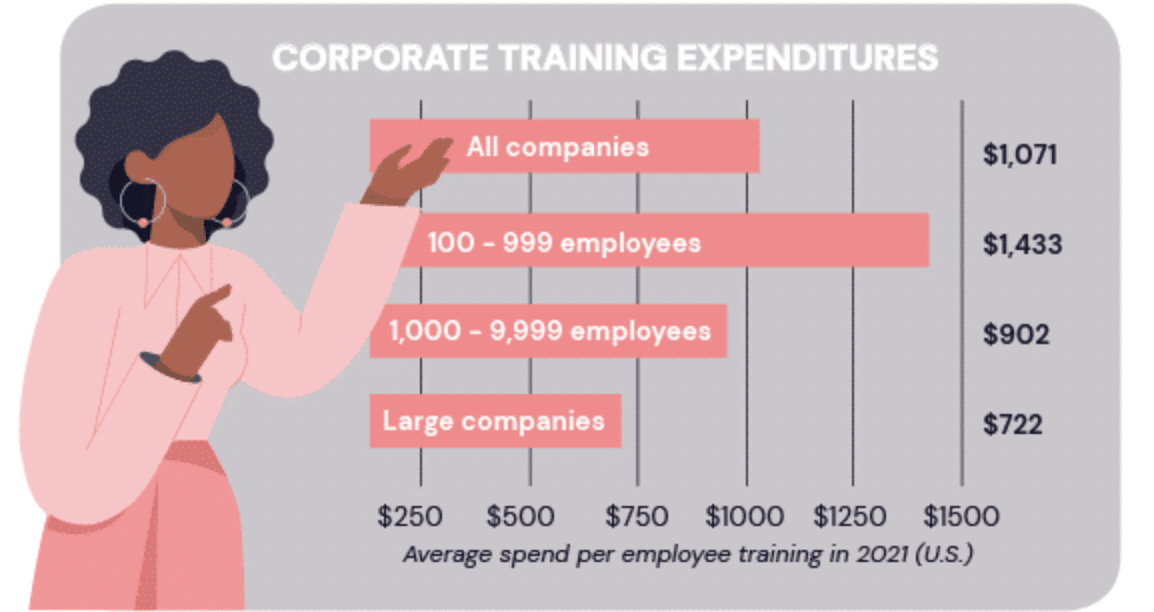Some things in life are easy to measure and understand, and some things are trickier to grasp: tracking a child’s growth through milestones like height, for example—easy to understand—for better or for worse. On the other hand, other things aren’t as easy to quantify, such as eLearning ROI. It’s especially slippery because it doesn’t always deal with numbers but with humans and their behavior.
As budgets tighten and the demand for accountability rises, measuring and optimizing the return on investment (ROI) of eLearning initiatives has never been more critical. In this blog post, we will explore the strategies, tools, and real-world case studies that can help you effectively measure and optimize eLearning ROI. So while you may not be able to assign a numerical value to the exact ROI you receive by implementing an eLearning program for training and education, it’s possible to identify the ways eLearning has improved efficiency, achieved a goal, and ultimately, balanced your bottom line.
Create measurable goals
Before you can measure your eLearning ROI, you must first create a vision for the end result.
Tom Kelly, VP of Internet Learning Solutions Group at Cisco Systems, Inc., tells Workforce Magazine, “To prove the full ROI of eLearning, you need to measure its value.” You can’t measure value without first visualizing the end result. Whether you’re aiming for better customer satisfaction, faster training, or better information retention, you’ll need to create your eLearning curriculum with that vision in mind. This can also help you relay your goals as you communicate with your instructional design expert.
Project timeline
While you may not be able to measure exactly what each user gets out of the eLearning experience, you can measure the time frame in which the curriculum is designed, delivered, and put into action.
By creating a realistic timeline, you can later measure eLearning ROI based on whether deadlines were met and the resources required to get the program from vision to completion and delivery. In general, the longer a project takes, the more resources you’re using, which eventually translates to lower ROI for the project.
Retention and efficiency
Some of your ROI won’t be apparent until after all of the users have completed the course material.
Ideally, you should start to see a return in the retention and application of the material in daily business. Whether the eLearning was a safety course for new recruits or a course to implement a new sales program, regular employee audits and evaluations can help you see whether or not the new program was worth the time and money put into it.
Production costs
It all boils down to the bottom line. You’ll be hard-pressed to efficiently measure eLearning ROI without a clear idea of what that investment was.
Don’t measure only monetary costs such as outsourcing the instructional design—take other elements into consideration, such as the time spent on the project, travel costs, content costs, and the actual expenditure of time and effort for the learners themselves. When there are lackluster results in spite of the production costs and time involved, you may need to rethink your strategy for user engagement and lower initial costs to better balance eLearning ROI.
Understanding eLearning ROI
Before diving into measurement strategies, it’s essential to grasp the concept of eLearning ROI. ROI in the context of eLearning refers to the value generated by your eLearning investments compared to the costs incurred. It involves assessing the impact of eLearning on employee performance, productivity, and, ultimately, the organization’s bottom line.

Key factors in measuring eLearning ROI
Measuring eLearning ROI goes beyond simple cost analysis. It involves considering several key factors:
- Learning outcomes: Assess the effectiveness of eLearning by evaluating whether it achieves the desired learning outcomes and skills improvement.
- Costs: Calculate both direct and indirect costs associated with eLearning development, deployment, and maintenance.
- Productivity: Measure the impact of eLearning on employee productivity, such as reduced training time, increased efficiency, and decreased error rates.
- Employee engagement: Evaluate the engagement levels of learners and their satisfaction with eLearning experiences.
- Business impact: Determine how eLearning contributes to achieving strategic business goals like increased revenue, reduced turnover, or improved customer satisfaction.
Methods for measuring eLearning ROI
Several methods can be used to measure eLearning ROI:
- Pre- and post- assessments: Conduct assessments before and after eLearning to quantify knowledge gain and skill improvement.
- Surveys and feedback: Collect feedback from learners to gauge their satisfaction and the perceived impact of eLearning.
- Kirkpatrick model: Utilize the four levels of Kirkpatrick’s model to assess reaction, learning, behavior, and results.
- ROI calculation: Calculate ROI by comparing the benefits generated from eLearning to the total costs incurred.
- LTEM (Learning-Transfer Evaluation Model): Use this framework for evaluating eLearning effectiveness, focusing on the practical application and transfer of knowledge and skills to real-world job performance.
Tools for measuring eLearning ROI
To effectively measure eLearning ROI, consider using dedicated eLearning analytics and reporting tools. A Learning Management System (LMS) often offers built-in analytics dashboards that track learner progress, completion rates, and assessment results. Additionally, specialized eLearning ROI software can help you calculate and visualize the financial impact of your eLearning initiatives.
Improving the measurement of eLearning ROI
To optimize eLearning ROI measurement, consider the following strategies:
- Align eLearning with business goals: Ensure that eLearning initiatives align with the organization’s strategic objectives to maximize their impact.
- Use advanced analytics: Leverage advanced analytics to gain deeper insights into learner behavior and performance.
- Continuous improvement: Regularly review and update eLearning content and delivery methods based on ROI data and learner feedback.
- Personalization: Customize eLearning experiences to individual learner needs and preferences to enhance engagement and effectiveness.
Challenges and considerations in measuring eLearning ROI
Measuring eLearning ROI can be challenging due to various factors, including the complexity of the learning environment, the need for data integration, and the time required to see results. Additionally, defining clear success metrics and isolating the impact of eLearning from other variables can be tricky.
Case studies: Successful eLearning ROI measurement
To illustrate the practical application of eLearning ROI measurement, we will explore real-world case studies of organizations that have achieved significant results through their eLearning initiatives. These case studies will showcase the diverse ways in which eLearning can deliver measurable returns.
- IBM: IBM has consistently saved millions of dollars by transitioning to eLearning for employee training. They reduced their training costs by 40 percent and cut the time required to train employees by 50 percent. By implementing eLearning, IBM has significantly reduced travel and accommodation expenses associated with traditional in-person training programs.
- McDonald’s: The fast-food giant McDonald’s adopted eLearning for training their staff in various locations worldwide. By delivering standardized training modules online, they reduced the costs associated with traditional classroom training and printed materials. McDonald’s estimated annual savings of $30 million after implementing eLearning.
- Siemens: Siemens, a global engineering company, turned to eLearning to train its vast and diverse workforce. They reported saving over $200 million annually by using eLearning for both technical and soft skills training. Siemens also found that eLearning allowed employees to complete training at their own pace, reducing time away from work and increasing productivity.
- CISCO: Cisco Systems, a multinational technology company, embraced eLearning to train its sales force and partners. By moving from traditional classroom training to virtual instructor-led training and on-demand eLearning modules, they achieved cost savings of approximately $142 million per year.
- Bank of America: Bank of America opted for eLearning to provide compliance training to its employees. The shift to eLearning helped the bank save millions of dollars annually in terms of reduced training delivery costs and travel expenses. Additionally, it allowed employees to complete training modules conveniently, reducing downtime.
- General Electric (GE): GE implemented eLearning to train its global workforce on various technical and leadership topics. By transitioning from in-person training to eLearning, they saved around $100 million in training costs within the first year alone. GE also noted that eLearning led to improved learning retention among employees.
These examples demonstrate the substantial cost savings achieved by organizations that have embraced eLearning as a means of training and development. By reducing travel expenses, eliminating the need for physical training materials, and increasing training efficiency, eLearning has proven to be a cost-effective solution for employee training across various industries.
The bottom line of eLearning
In today’s competitive landscape, organizations must invest wisely in their eLearning initiatives. Measuring and optimizing eLearning ROI is not just about cost efficiency—it’s about ensuring that your investments lead to improved employee performance, enhanced productivity, and tangible business outcomes. By implementing effective measurement strategies, leveraging the right tools, and learning from successful case studies, you can harness the full potential of eLearning to drive positive ROI for your organization.






